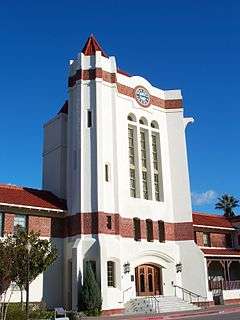Agnews Developmental Center
|
Agnews Insane Asylum | |
 | |
   | |
| Location | 4000 Lafayette Ave., Santa Clara, California |
|---|---|
| Coordinates | 37°23′38″N 121°57′10″W / 37.39389°N 121.95278°WCoordinates: 37°23′38″N 121°57′10″W / 37.39389°N 121.95278°W |
| Built | 1906 |
| Architect | Stocking, Leonard, State Architect; Sellon & Hennings, McDougall, George |
| Architectural style | Mission Revival—Spanish Colonial Revival |
| NRHP Reference # | 97000829 |
| Added to NRHP | August 13, 1997 |
Agnews Developmental Center was a psychiatric and medical care facility, located in Santa Clara, California.
In 1885, the center, originally known as "The Great Asylum for the Insane",[1] was established as a facility for the care of the mentally ill. The main structure, a red brick edifice, was located on land near Agnew's Village, which later became part of Santa Clara. By the early twentieth century, Agnews boasted the largest institutional population in the South San Francisco Bay area, and was served by its own train station which stood at the west end of Palm Drive across Lafayette Street; the station building remained until vandalism and fire precipitated its demolition in the 1990s.
In 1926, the center was expanded to include a second campus about 2 miles (3 km) to the east in San Jose. Individuals with developmental disabilities were first admitted to a special rehabilitation program in 1965. Programs for the mentally ill were discontinued in 1972. Since then, the center has been used exclusively for the care and treatment of persons with developmental disabilities.[2]
1906 earthquake
During the 1906 San Francisco earthquake, Agnews became infamous as the site of the Santa Clara Valley's greatest loss of life resulting from the quake. The Daily Palo Alto reported: "The position of the people in Agnews is critical; a number of insane persons having escaped from the demolished asylum, are running at random about the country." 117 patients and staff were killed and buried in mass graves on the site. The main building and some others were irreparably damaged.
Following this disaster, Agnews was rebuilt in the Mediterranean Revival architecture styles of Mission Revival—Spanish Colonial Revival, in a layout resembling a college campus of two-story buildings. It re-opened circa 1911 as Agnews State Mental Hospital. The facility was a small self-contained town, including a multitude of construction trade "shops", a farm which raised pigs and vegetable crops, a steam generating power plant for heating the buildings by steam, and even a fire department.
West campus closure leads to controversial sale

The original west campus was closed in 1998 as part of a plan to reduce and eventually close the center.
When the west campus closed, the use of the land was the subject of local controversy. In April 1997, it was announced the state would sell an 82.5-acre (33.4 ha) parcel of the campus to Sun Microsystems for its corporate headquarters and R&D campus. Some objected to the arranged sale of this prime public land to a profitable corporation at the peak of a local economic and real-estate boom, while others valued the presence of a prominent high-tech employer. Also at issue was the preservation of and public access to historic Agnews Developmental Center buildings. Sun agreed to restore four of the historic buildings (the auditorium, the clock tower, the superintendent's villa, and the administration building) and to keep some of the facilities available for public use. An outdoor exhibit open to the public displays information and photographs regarding the center and its history.
In addition to the Sun deal, the Rivermark master planned community was allocated 152 acres (62 ha) for a variety of residential, retail, public school, and open space uses.
The Agnews site was added to the National Register of Historic Places (under the name "Agnews Insane Asylum") on August 13, 1997.[3]
Sun was acquired by Oracle Corporation in 2010; the campus continues to be used as an Oracle R&D facility and conference center.
East campus closure
In March 2009, the last patient moved out of the east campus and the residential facility was closed. The east campus provided outpatient clinic services through April 2011.
In July 2011, the Regional Project of the Bay Area and the Community State Staff Administration moved to Campbell and continued providing support to patients in the local area.
With the final sale of the land pending, the east campus was vacated and the land was turned over to the Department of General Services.[4]
In July 2014, the City of San Jose and the Santa Clara Unified School District purchased the property from the State of California for $80 million[5] with the intent to build a K-8, High School, and city park.
In popular media
The punk rock band Green Day recorded the music video for their 1994 song "Basket Case" at Agnews.
References
- ↑ Context Magazine, When the Going Gets Tough... Archived October 17, 2006, at the Wayback Machine.
- ↑ "Agnews Developmental Center". California Department of Developmental Services. Retrieved 2011-01-05.
- ↑ National Park Service (2008-04-15). "National Register Information System". National Register of Historic Places. National Park Service.
- ↑ "Agnews Developmental Center". Retrieved 3 July 2016.
- ↑ "City of San Jose Parks, Recreation and Neighborhood Services".
External links
| Wikimedia Commons has media related to Agnews Developmental Center. |
- California Department of Developmental Services
- Article covering land re-use controversy
- Agnews Insane Asylum, U.S. National Park Service
- New Campus, New Home, a video on the construction of the Sun Microsystems campus and preservation of the Agnews buildings
- Agnews Historical Cemetery at Find a Grave
